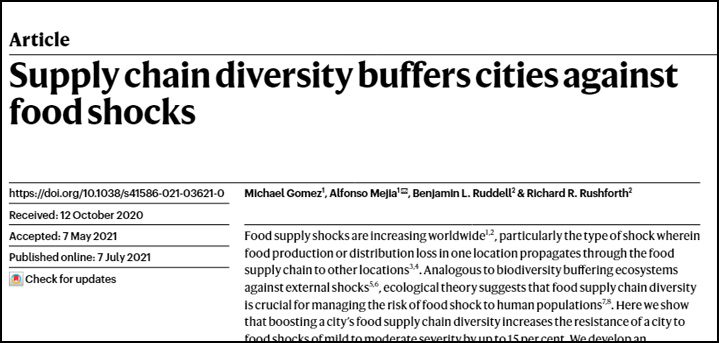First published: July 7, 2021 on The NAU Review
Referencing “Supply chain diversity buffers cities against food shocks”
Gomez, M., Mejia, A., Ruddell, B.L. & Rushforth, R. (2021).
A new paper in Nature lays out the way natural ecosystems parallel U.S. supply chains and how American cities can use these tools to strengthen their supply chains.
The paper, “Supply chain diversity buffers cities against food shocks,” is co-authored by Benjamin Ruddell, director of the FEWSION Project and the School of Informatics, Computing, and Cyber Systems at Northern Arizona University, and Richard Rushforth, an assistant research professor in SICCS, in collaboration with FEWSION project researchers at Penn State. FEWSION is an NSF-funded collaboration that uses comprehensive data mapping to monitor domestic supply chains for food, water and energy down to the county level…
Read the full article on The NAU Review here.
Abstract
Food supply shocks are increasing worldwide1,2, particularly the type of shock wherein food production or distribution loss in one location propagates through the food supply chain to other locations3,4. Analogous to biodiversity buffering ecosystems against external shocks5,6, ecological theory suggests that food supply chain diversity is crucial for managing the risk of food shock to human populations7,8. Here we show that boosting a city’s food supply chain diversity increases the resistance of a city to food shocks of mild to moderate severity by up to 15 per cent. We develop an intensity–duration–frequency model linking food shock risk to supply chain diversity. The empirical–statistical model is based on annual food inflow observations from all metropolitan areas in the USA during the years 2012 to 2015, years when most of the country experienced moderate to severe droughts. The model explains a city’s resistance to food shocks of a given frequency, intensity and duration as a monotonically declining function of the city’s food inflow supply chain’s Shannon diversity. This model is simple, operationally useful and addresses any kind of hazard. Using this method, cities can improve their resistance to food supply shocks with policies that increase the food supply chain’s diversity.

